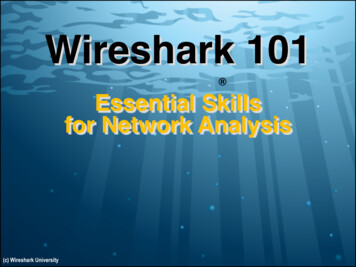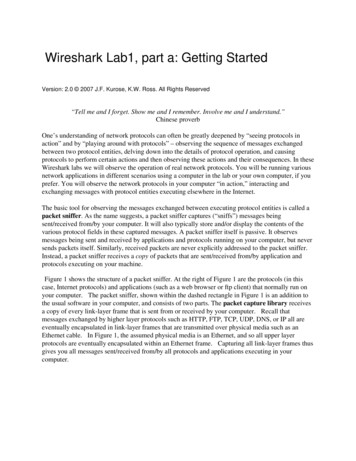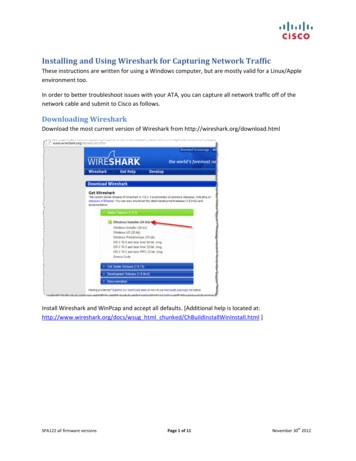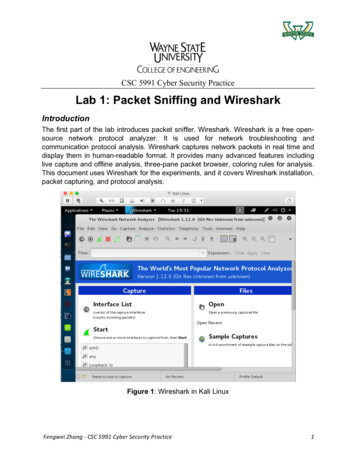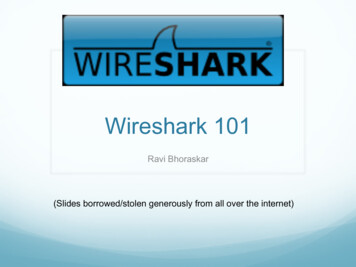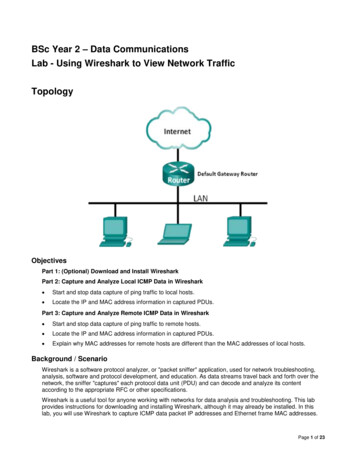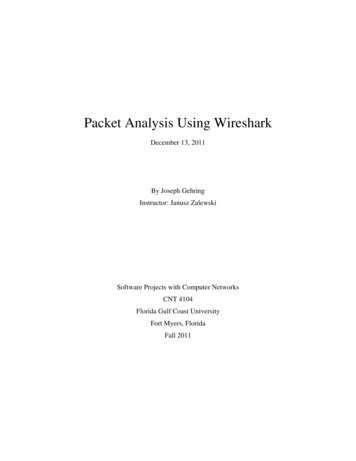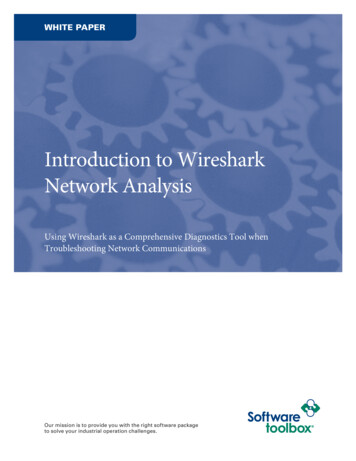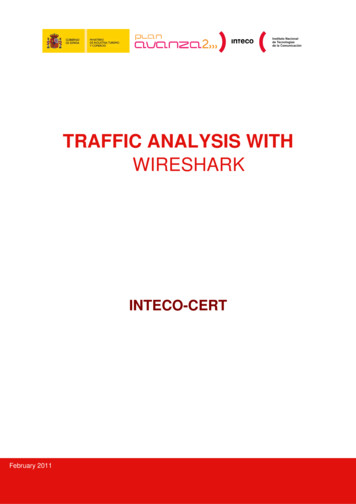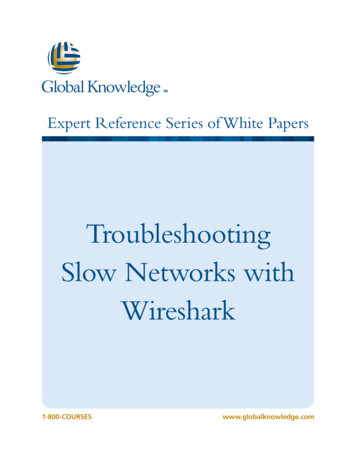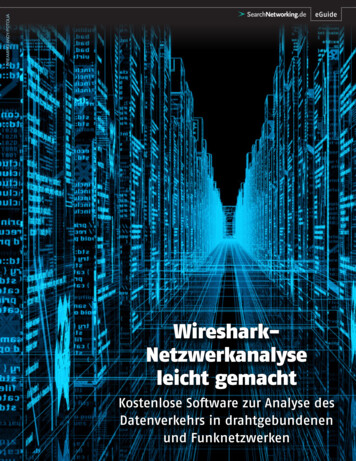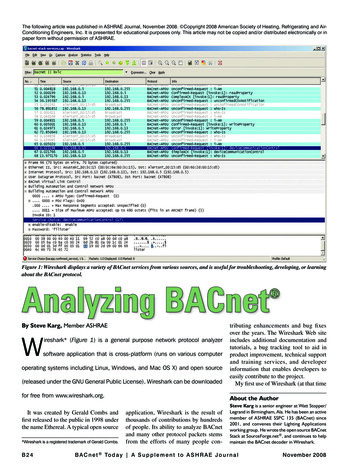
Transcription
The following article was published in ASHRAE Journal, November 2008. Copyright 2008 American Society of Heating, Refrigerating and AirConditioning Engineers, Inc. It is presented for educational purposes only. This article may not be copied and/or distributed electronically or inpaper form without permission of ASHRAE.Figure 1: Wireshark displays a variety of BACnet services from various sources, and is useful for troubleshooting, developing, or learningabout the BACnet protocol.Analyzing BACnet By Steve Karg, Member ASHRAE(released under the GNU General Public License). Wireshark can be downloadedtributing enhancements and bug fixesover the years. The Wireshark Web siteincludes additional documentation andtutorials, a bug tracking tool to aid inproduct improvement, technical supportand training services, and developerinformation that enables developers toeasily contribute to the project.My first use of Wireshark (at that timefor free from www.wireshark.org.About the AuthorWireshark* (Figure 1) is a general purpose network protocol analyzersoftware application that is cross-platform (runs on various computeroperating systems including Linux, Windows, and Mac OS X) and open sourceIt was created by Gerald Combs andfirst released to the public in 1998 underthe name Ethereal. A typical open source*Wireshark is a registered trademark of Gerald Combs.B 2 4application, Wireshark is the result ofthousands of contributions by hundredsof people. Its ability to analyze BACnetand many other protocol packets stemsfrom the efforts of many people con-Steve Karg is a senior engineer at Watt Stopper/Legrand in Birmingham, Ala. He has been an activemember of ASHRAE SSPC 135 (BACnet) since2001, and convenes their Lighting Applicationsworking group. He wrote the open source BACnetStack at SourceForge.net , and continues to helpmaintain the BACnet decoder in Wireshark.B A C n e t To d a y A S u p p l e m e n t t o A S H R A E J o u r n a lNovember 2008
the software was known as Ethereal) to handle BACnet decodinghappened in 2005 when a customer site hundreds of miles fromme was experiencing problems with a controller that stoppedresponding after connecting it to the BACnet network at the site.The problem occurred intermittently, but usually after severalweeks of BACnet network activity. I placed a laptop PC at thesite, connected the BACnet network to the laptop PC using anEthernet hub, and set Ethereal in packet record mode. A coupleof weeks later, the maintenance supervisor called me and saidthat the controller had stopped responding. He stopped theEthereal packet recording operation, saved the data, and sentme the 400 MB file on a CD-ROM.My first look at the BACnet data from the customer siteusing Ethereal left me desiring more detailed information.The BACnet decoding only showed BACnet Confirmed orUnconfirmed APDU messages and raw data, without namingthe BACnet service or showing data names or values in the services. Understanding the nature of this open source application,I immediately set to work downloading the Ethereal protocolanalyzer source code and the required libraries, reading thedeveloper documentation, and compiling.In only a few days, I had modified the Ethereal code to display the specific BACnet services, and submitted a patch to theEthereal developers. The following day another BACnet patcharrived from a developer in Berlin who had reworked an earlierpatch submission, which had added the majority of BACnetapplication decoding. The large capture from the customer siterevealed that my controller was receiving bursts of 30 to 50WriteProperty requests about every 10 seconds. I configureda similar test in my office to simulate the customer site. Mycontroller stopped responding in a few hours, and I was able todebug my application code and correct the firmware.Additional patches to Ethereal by me and others enhancedthe property decoding and fixed a number of subtleties over thefollowing weeks. The BACnet decoding in Wireshark continuesto improve and evolve along with the BACnet standard, andtoday is very good.Wireshark can monitor and decode most BACnet packets thatare received primarily from an Ethernet interface. It can alsoreceive packets from an ARCNET interface. The software is notyet able to directly capture or decode packets from a BACnetPTP (serial) or a BACnet MS/TP (EIA-485) interface. However,BACnet MS/TP can be supported by adding an external interface (Figure 2), which sends Ethernet SNAP protocol packets.Wireshark does not yet support BACnet Segmentation. Thesefeatures will probably be added someday because someone willeventually be motivated to add the missing functionality to thishighly regarded open source tool.Wireshark can import and export packet files in a variety ofnetwork analyzer formats. The libpcap file format is the software’s default file format.Using Wireshark for Live CapturesTo monitor or record BACnet traffic, you must be able to“see” the network traffic from the computer running the protocolNovember 2008Figure 2: Wireshark and a BACnet MS/TP capture from an externalinterface, which sends Ethernet SNAP protocol packets.analyzer. This usually requires connecting the computer andBACnet devices to an Ethernet hub, as unicast traffic betweendevices may not be seen on all ports of an Ethernet switch(bridge). Ethernet switches may be used if they have the ability to span, monitor, or mirror all port traffic and send it to asingle port. The computer network interface must also supportpromiscuous mode, where the interface supplies the protocolanalyzer with all the network packets it sees.Selecting the network interface to monitor or capture is accomplished through the Capture menu options, under Interfacesor Options. The Capture Options dialog (Figure 3) offers theselection of a capture interface, optional display of packets inreal time or automatic scrolling, MAC, network, or transportname resolution, and the ability to save a file or multiple fileswhile capturing. The Options dialog also provides the abilityto limit the capture by providing “Stop Capture” options aftera number of packets, megabytes, or minutes.Wireshark supports capture and display filtering, and the syntax for a capture filter and a display filter is different. A capturefilter limits the packets captured to a couple of specific headerfields. The capture filter expressions can include a specific protocol (ether, fddi, ip, arp, rarp, decnet, lat, sca, moprc, mopdl,tcp, udp), a direction (src, dest, src and dest, src or dest), andB A C n e t To d a y A S u p p l e m e n t t o A S H R A E J o u r n a lB25
logical operations (nor, and, or). These filter expressions can be used on a BACnet/IP network to filter out any non-BACnet/IP traffic. A common capture filter toonly capture standard BACnet/IP packetswould be “udp port 47808”.Before we start our capture, we shouldconsider our Display Options. Wiresharkcan display the packets in real-time andcan automatically scroll the packets whilethey are being received, which is fun towatch, but not as useful when trying tosee specific packets. The latest builds ofthe software enables automatic scrollingduring a capture by selecting the lastpacket on the display. The software alsopermits hiding of the Capture Info dialogbox that summarizes the count and typeof packets captured.Another option to consider is CaptureFile(s). Although Wireshark can save aFigure 3: Wireshark Capture Options dialog box allows control of the capture display, namecapture or portions of a capture after itresolution, capture files, capture interface, capture filter, and the ability to stop after so manyis displayed, sometimes it is necessarypackets, bytes, or time.to capture over a longer period of time.Wireshark has the ability to capture to a file or even multiple Control or BACnet/IP specific decoding), BACnet (BACnetfiles. The software automatically appends unique identifiers NPDU or network layer decoding), and BACapp (BACnetto files when multiple files are used. The file or files can be APDU or application layer decoding). A common display filterlimited to size, time or number of files, or can save indefinitely, to view all BACnet messages containing an NPDU would beonly limited to the amount of disk space available. When I am “bacnet.” A display filter to view only BACnet WritePropertycapturing for days, weeks, or months, I normally disable the service packets would be “bacapp.confirmed serviceDisplay Option for “Update list of packets in real time” to limit 15,” where 15 is the service choice for the WritePropertythe amount of display memory used.service of a BACnet APDU Confirmed Request.Many, but not all, of the decoded variables are availableSelecting “Start” from Capture Options begins the capture.Selecting “Stop” from the “Capture” menu stops the capture. for use in a display filter. The name of the variable can befound by first selecting the line of the variable decoding, andThe capture can be saved to a file or discarded.seeing the text, such as “bacapp.confirmed service,” shownDisplay Filteringin parenthesis in the lower left corner status box of the WireA common BACnet configuration issue that I have seen dur- shark window. Display filters (Table 1) can be applied to aing the commissioning of a BACnet network is due to some data capture by using the “Apply as Filter” context menu indevice or workstation writing to a Present Value property of Wireshark. The context menu can be activated by selectingan object at a higher priority than it should. This usually makes a particular packet or data element of a packet, and usingan output point unresponsive to other network applications. the context button on the mouse (e.g., the right button on aFinding the writer of the high priority usually involves some Windows mouse).forethought at the end-device, or just some monitoring withThe packets displayed using a display filter can also be savedWireshark. Sifting through many hours or days of data packets as a separate file using “Save-As” from the “File” menu. Thisis made easier by using the display filtering that is built into is useful when working with large capture files.Some BACnet installations use BACnet/IP with a UDP portthe software.The display filter (Figure 4) allows for protocol specific filter- other than 47808 (0xBAC0). The Wireshark context menu aling, during the live capture, after the capture has been stopped, lows for decoding BACnet messages on other UDP ports usingor after opening a capture file in the display. It can be built us- the “Decode As.” option (Figure 5) and selecting BVLC.The default Wireshark time display format is seconds sinceing the Wireshark Filter Expression wizard, by typing specificvalues into the filter box, or by using the context menu. Each the beginning of the capture. Other useful formats includeprotocol decoder has its own expression words. The BACnet seconds since the previous packet, and time of day. Being abledecoders are currently defined as BVLC (BACnet Virtual Link to change the reference or start time for the time display is useB 2 6B A C n e t To d a y A S u p p l e m e n t t o A S H R A E J o u r n a lNovember 2008
ful when checking for bandwidth issues.I monitored a college campus Ethernetnetwork port using a hub connected toa BACnet router, which also connectedto a 156K ARCNET segment. I found,using the software, that the campusnetwork was producing thousands ofBACnet UnconfirmedCOV (change ofvalue) broadcast packets per minute, andthis was saturating the 156K ARCNETsegment and causing slow response andretransmits from the devices on the ARCNET segment. Adjusting the offendingobjects COV Increment property aroundthe campus eliminated the issue.Developing BACnet ProductsWireshark is well known for being usedin software and communications protocoldevelopment, and its use during BACnetsoftware development is no exception.Timing information, the raw bytes onthe wire, and the decoded meaning ofthe bytes on the wire provide immediatefeedback to a BACnet developer. TheWireshark source code may also provide deeper insight into how particularpackets or properties may be formedand decoded.Wireshark, accompanied by a BACnettesting tool, is a common setup for testing and validating a BACnet device. Thesoftware can provide the evidence (acapture) from a testing session, whichcan be used by the BACnet developerto find and fix a problem discoveredduring testing.Wireshark From the Command LineWireshark can also be used from the Figure 4: Wireshark default display, showing the ability to prepare or apply a display filter.command line (Command Prompt underWindows; shell or console under Linuxor Unix). The first tshark command line option that I normallyOther command line tools are shipped with Wireshark inuse is “-D”, which provides me an enumerated list of interfaces cluding:that I can use for capturing. Then I use the “-i 2” or whichever dumpcap—captures network traffic but does not displayinterface number I want to capture from as the command linethe network traffic;option to tshark. The “-w filename.cap” command line option capinfos—reads a saved capture file and displays statisticsis useful when I want to capture to a file, but don’t necessarilyabout that file;want to launch the Wireshark GUI. The amount of disk space or editcap—edit and translate the format of a capture file;number of files stored during a capture can be controlled using mergecap—merges multiple capture files into one file;the “-b” command line option followed by duration, file size, text2pcap—generates a capture file from an ASCII hexaor number of files options. More details about the specific opdecimal dump of packets; andtions can be found by asking tshark for help using the “--help” rawshark—a tool for displaying packets and specifiedcommand line option.fields from a capture file.B 2 8B A C n e t To d a y A S u p p l e m e n t t o A S H R A E J o u r n a lNovember 2008
Free to Download, Use, and ShareIt is not always convenient for meto travel to a site that is experiencingBACnet-related network problemsso that I can analyze and solve theproblem. I was asked to help diagnosean installation where two BACnetvendors were unable to communicateusing BACnet/IP. I asked for a Wireshark capture of the communicationattempts. They did not have Wiresharkinstalled on their laptop computers, sothey went to the Wireshark Web siteto download the free tool. I guidedthem through the capture process aftersuccessful installation of the tool, andthey emailed me the results. They alsoshared Wireshark with the local sitetechnicians who would be able to perform Wireshark network analysis andsend us the captures.I pondered the WhoIs and I-Am requests from the capture for a clue intothe problem, but both requests appearedto be well formed. Although both devices were using the standard BACnet/IP port number 47808, I did notice thateach was using a different IP broadcastaddress. Further investigation revealedthat the site was using an unusual IPsubnet mask for their control systemson the network: 255.255.254.0. TheBACnet device using an older GNU/Linux operating system was unable toform the correct IP broadcast addressby using just the IP subnet mask. Thevendor changed the network configuration script in their device to calculateand set the broadcast address directly.The local technicians installed the patch,performed some Wireshark networkanalysis, and sent us the captures thatshowed that the broadcast problem wassolved.Capture Filtersudp port 47808BACnet/IP packets on UDP port47808udp port 47808 or udp port 47809BACnet/IP packets on UDP port47808 or 47809Display Filtersbvlc bacnet bacappBACnet packetsbacnetBACnet NPDU packetsbacnet.mesgtypBACnet Network Layer (router)packetsbvlcBACnet/IP packetsbvlc.function 0x0bBACnet/IP Broadcast packetsbacappBACnet APDU packetsbacapp.confirmed service 12BACnet ReadProperty packetsbacapp.confirmed service 15BACnet WriteProperty packetsbacapp.unconfirmed service 0BACnet I-Am packetsbacapp.unconfirmed service 8BACnet WhoIs packetsbacapp.unconfirmed service 2BACnet UnconfirmedCOVNotification packetsTable 1: A list of commonly used Wireshark filters for BACnet. Display filter expressions canbe combined using logical operators such as “and”, “or”, “xor”, and “not”. A display filterexpression can use a variety of comparison operators such as “ ”, “! ”, “ ”, “ ”, “ ”,and “ ”. Additional details can be found in the Help Contents included with Wireshark.SummaryWireshark is software that understandsthe detailed structure of many differentnetworking protocols, including BACnet.The software is able to capture, display,and save the various BACnet messages,services, attributes, and properties alongwith their meanings. It has powerful display filters that can be used to selectivelyNovember 2008Figure 5: Wireshark “Decode As” dialog showing BACnet/IP port 47809 decoded as BVLC.highlight and color packet information.The software runs on most computer platforms, whether graphical or commandline. It can import and export a varietyof network analyzer file formats. Best ofall, Wireshark is free!B A C n e t To d a y A S u p p l e m e n t t o A S H R A E J o u r n a lB29
capture or portions of a capture after it is displayed, sometimes it is necessary to capture over a longer period of time. Wiresh
